 Row 1: Minnow, Atlantic Salmon, White-clawed Crayfish Row 2: River Lamprey, Blue-winged Olive Mayfly larva, Brown Trout |
|
Let me know
page changes |
| powered
by ChangeDetection |
 Row 1: Minnow, Atlantic Salmon, White-clawed Crayfish Row 2: River Lamprey, Blue-winged Olive Mayfly larva, Brown Trout |
|
Let me know
page changes |
| powered
by ChangeDetection |
Atlantic Salmon
The Atlantic salmon, Salmo salar, spends most of its life in freshwater where the eggs are laid and juveniles mature, being known initially as parr and later as smolt, migrating to the sea to feed and grow, before returning to spawn in streams and rivers. Average adult specimens measure 71 to 76 cm long and weigh 3.6 to 5.4 kg. Record-sized specimens reach a maximum of 153 cm with a weight of 45 kg. The colouration of young Atlantic salmon does not resemble their adult stage. While they live in fresh water, they have blue and red spots. As they mature, they take on a silver-blue sheen. When adult, the easiest way of identifying them is by the black spots predominantly above the lateral line, although the caudal fin is usually unspotted. When they reproduce, males take on a slight green or red colouration. Atlantic Salmon are declining throughout most of their range and are listed as requiring protection in the European Union Habitats Directive and the Bern Convention. They thrive only in the cleanest of rivers and are far less numerous than in the past. During the last 30 years, numbers of wild salmon returning from the sea have fallen by more than half.
River Lamprey
The river lamprey or lampern, Lampetra fluviatilis, is a primative jawless fish. It is found in coastal waters around almost all of Europe. It feeds as a parasite by attaching itself to the side of another fish and rasping with its sucker mouth. The reproductive cycle is similar to that of salmon. River lampreys migrate upstream from the sea in autumn or winter. Spawning activity is greatest in the springtime and young river lampreys spend several years in soft sediments in their natal rivers and streams before migrating to sea as adults. It is not currently known how long these animals spend in marine habitats be fore making the return trip to spawn. Good water quality is very important to lampreys, and hence threatened by any habitat degradation. Maintaining a strong population in the UK is vital for the health of the species Europe-wide.
White-clawed Crayfish
The white-clawed or the Atlantic stream crayfish Austropotomobius pallipes is is one of the largest freshwater invertebrates in the UK. White-clawed crayfish live in small streams, brooks, rivers, lakes, some ponds, reservoirs and water-filled quarries. They prefer clear, well-oxygenated, alkaline water without too much fine sediment. Typical favoured habitat features includes crevices in rocks, gaps between stones, aquatic plants and submerged tree roots, which all provide refuges for them to hide in. They are very susceptible to pollution and dredging and canalization of rivers. There has been a substantial reduction in the extent of their distribution in recent years due to reduced quality and pollution of watercourses, competition and disease transmitted by introduced species of crayfish and, habitat modifications along many rivers and streams. As more and more rivers become populated by introduced crayfish many populations of white-clawed crayfish are becoming increasingly isolated or lost. The British populations represent the greatest concentration of the species in Europe.
Brown Trout
The brown trout Salmo trutta is a relative of the salmon. There are both purely freshwater populations and a sea going form known as the sea trout. The latter migrates to the oceans for much of its life and returns to freshwater only to spawn. Sea trout in the UK and Ireland have many regional names, including sewin (Wales), finnock (Scotland), peal (West Country), mort (North West England) and white trout (Ireland). The brown trout is a medium-sized fish, growing to 20 kg or more in some localities, although in many smaller rivers a mature weight of 1 kg or less is common. The spawning behavior of brown trout is similar to that of the Atlantic salmon. A typical female produces about 2,000 eggs per kilogram of body weight at spawning.
Blue-winged Olive Mayfly larva
Mayflies are relatives of the dragonflies and damselflies. They are aquatic insects whose immature stage (called "naiad" or, colloquially, "nymph") lives for a year or more in freshwater. The lifespan of an adult mayfly is very short and varies depending on the species. The primary function of the adult is reproduction so the mouthparts are vestigial and the digestive system is filled with air. It often happens that all the mayflies in a population mature at once and emerge from the water. This is known as a ‘hatch’, and for a day or two in the spring or autumn, mayflies will be everywhere, dancing around each other in large groups, or resting on every available surface.
The minnow Phoxinus phoxinus is a small freshwater fish (8 to 10cm long) of the carp family. Common throughout much of Eurasia, the minnow prefers cool (12–20 C) streams and well-oxygenated lakes and ponds. It is noted for being a gregarious species, shoaling in large numbers. Minnows are small, slender, dark-coloured fish with a blunt snout and small scales. The belly is cream to pearly, changing in the male to red in spawning season where the males also have tubercles.
Products issued
The labels will be used in Post & Go machines at Post Offices around
the country, and also at Autumn Stampex.
A mint set of 6 x 1st will also be available from Royal Mail's Tallents
House Bureau in a pack similar to a presentation pack. All values in
the pack are 1st Class.
Special Postmarks
Postmarks available for the day of issue will be shown here These are
not to scale. These postmarks cannot be obtained after the date
of issue.
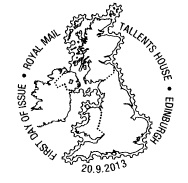 |
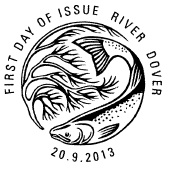 |
 |
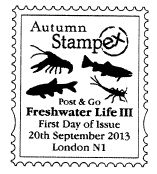 |
| Ref FD1320TH Philatelic Bureau Official Postmark illustrated with a map of the British Isles |
Ref FD1320PL River, Dover |
Ref FD1315NP River, Dover |
Ref L12952 Autumn Stampex, Post & Go, Freshwater Life III, First Day of Issue London N1 |
 |
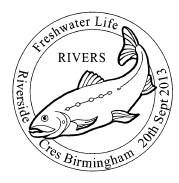 |
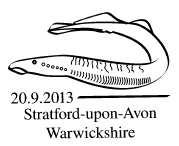 |
|
| Ref M12956 Freshwater Life Gloucester | Ref M12957 Riverside Cres, Birmingham |
Ref M12958 Stratford-upon-Avon, Warwickshire |
This page created 13 September 2013
If you wish to be told when this page is updated, please use the
ChangeDetection box at the top of this page.
If you have any questions, please email
us.
NB: all emails will be acknowledged in 1-2 days unless we are away (see home page). If you do not receive an acknowledgement please email us from a different address (eg hotmail, gmail).
|
|
|
|
|||
|
Norvic Philatelics, PO Box 119, Dereham, NR20 3YN, GB. UK Phone: 08450 090939 -- Skype:ian.billings-norvic |
|||||